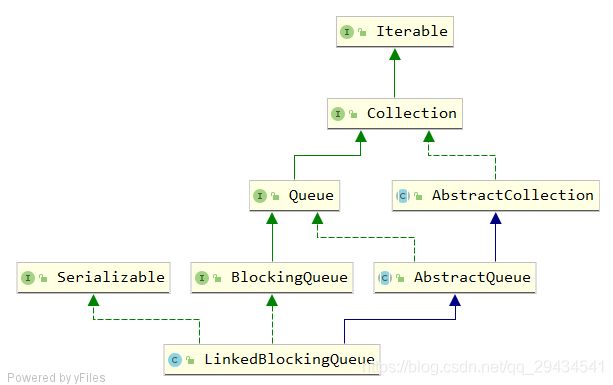- 【Java】已解决:java.util.concurrent.CompletionException
屿小夏
java开发语言
文章目录一、分析问题背景出现问题的场景代码片段二、可能出错的原因三、错误代码示例四、正确代码示例五、注意事项已解决:java.util.concurrent.CompletionException一、分析问题背景在Java并发编程中,java.util.concurrent.CompletionException是一种常见的运行时异常,通常在使用CompletableFuture进行异步计算时出现
- Java并发编程-AQS详解及案例实战(上篇)
猿与禅
Java技术栈源码分析javaAQS并发编程原理
文章目录AQS概述AQS的核心概念AQS的工作原理AQS的灵活性使用场景使用指南使用示例AQS的本质:为啥叫做异步队列同步器AQS的核心机制“异步队列”的含义“同步器”的含义总结加锁失败的时候如何借助AQS异步入队阻塞等待AQS的锁队列加锁失败时的处理流程异步入队的机制总结ReentractLock如何设置公平锁策略以及原理设置公平锁策略公平锁的运作原理尝试获取锁释放锁性能与公平性的权衡tryLo
- Java高并发编程详解系列-深入理解Thread构造
nihui123
高并发Java高并发Java高并发
上篇分享中主要是对线程的基本概念和基本操作做了一个分享,同时提出了两种常用的创建多线程的方法,当然在后期的分享中也会提及到更多的创建线程的方式,到后期的分享的时候再说。这次主要是深入的理解一下Thread的构造函数,通过构造函数对于Thread有一个更加深入的了解。这里首先提供一个JDK1.6的ThreadAPI截图线程命名规范 从源码分析可以看到在Thread类中默认提供了线程的命名方式,这个
- Java高并发编程详解系列-Balking设计模式
nihui123
高并发设计模式java编程语言
导语 在实际操作中当某个线程因为发现其他线程正在进行相同的工作而放弃即将开始的任务,这种情况就被称为是Balking模式,Balking英文的意思是犹豫。在多个线程监控某个共享变量,A线程监控到共享变量发生变化后立即触发某个动作,但是这个这个时候发现了B线程也对该变量开始了行动,这个时候A变量就放弃了准备工作。下面就来详细的讲解一下关于Balking模式什么是Balking模式 在餐厅吃饭的时
- Java高并发编程详解系列-Future设计模式
nihui123
高并发Java高并发Future高并发
导语 假设,在一个使用场景中有一个任务需要执行比较长的时间,通常需要等待任务执行结束之后或者是中途出错之后才能返回结果。在这个期间调用者只能等待,对于这个结果Future设计模式提供了一种凭据式的解决方案。在日常生活中,这种方案也是存在的。例如去洗衣店洗衣服,当你把衣服放到洗衣店,等他洗完需要一段时间,这个时候洗衣店就会给你一凭证,你可以通过这个凭证到时候去取洗好的衣服。这个例子就是生活中的Fu
- Java 并发编程:Java 线程池的介绍与使用
栗筝i
栗筝i的Java技术栈#Java基础栗筝i的Java技术栈Java基础Java并发Java线程池
大家好,我是栗筝i,这篇文章是我的“栗筝i的Java技术栈”专栏的第024篇文章,在“栗筝i的Java技术栈”这个专栏中我会持续为大家更新Java技术相关全套技术栈内容。专栏的主要目标是已经有一定Java开发经验,并希望进一步完善自己对整个Java技术体系来充实自己的技术栈的同学。与此同时,本专栏的所有文章,也都会准备充足的代码示例和完善的知识点梳理,因此也十分适合零基础的小白和要准备工作面试的同
- Python 课程8-多线程编程和多进程编程
可愛小吉
Python教學python开发语言threadingmultiprocessing
前言在现代编程中,处理并发任务是提高程序性能的关键之一。Python提供了多线程(threading)和多进程(multiprocessing)两种方式来实现并发编程。多线程适用于I/O密集型任务,而多进程则更适合CPU密集型任务。通过这两种技术,你可以高效地处理大规模数据、加速程序执行并优化资源利用。在本篇详细教程中,我们将讨论如何使用Python的threading模块实现多线程,以及如何使用
- Java并发复习
vd_vd
Java并发安全容器java开发语言
Java基础1.为什么要使用并发编程?一般我们工作的电脑都有多核,我们创建多个线程,然后操作系统可以将多个线程分配给不同的CPU去执行,每个CPU执行一个线程,这样就提高了CPU使用效率。在网络购物中,我们买了一个东西的同时,需要减库存,生成订单等等这些操作,就可以进行拆分利用多线程的技术完成。面对复杂业务模型,并行程序串行会比程序更适应业务需求,而并发编程更能吻合这种业务拆分。->充分利用多核C
- 多线程的使用-->5:并发编程的特性
路ZP
java开发语言
目录1.并发编程特性:2.并发编程的特性之一:原子性3.并发编程的特性之一:可见性3.1JVM内存模型3.2JMM(Java内存模型)4.并发编程的特性之一:有序性1.并发编程特性:多线程是一种程序开发或设计环境并发编程是一种程序设计概念或设计目标,在多线程开发环境中,同一系列的程序设计与机制的使用,确保多线程开发环境是稳定的,快速的,性能优秀的。并发编程具有3个特征原子性可见性有序性在多线程开发
- 【Python系列】异步任务的终止
Kwan的解忧杂货铺@新空间代码工作室
s2Pythonpython开发语言
欢迎来到我的博客,很高兴能够在这里和您见面!希望您在这里可以感受到一份轻松愉快的氛围,不仅可以获得有趣的内容和知识,也可以畅所欲言、分享您的想法和见解。推荐:kwan的首页,持续学习,不断总结,共同进步,活到老学到老导航檀越剑指大厂系列:全面总结java核心技术,jvm,并发编程redis,kafka,Spring,微服务等常用开发工具系列:常用的开发工具,IDEA,Mac,Alfred,Git,
- 浅谈C#之线程锁
CN.LG
C#jvm开发语言c#
一、基本介绍锁是一种同步机制,用于控制多个线程对共享资源的访问。当一个线程获得了锁时,其他线程将被阻塞,直到该线程释放了锁。在并发编程中,多个线程同时访问共享资源可能导致数据竞争和不确定的行为。锁可以确保在任意时刻只有一个线程可以访问共享资源,从而避免竞态条件和数据不一致性问题。二、锁的作用原理锁的作用原理通常涉及到内部的互斥机制。当一个线程获得锁时,它会将锁标记为已被占用,其他线程尝试获取该锁时
- 【Python系列】使用切片移动元素位置
Kwan的解忧杂货铺@新空间代码工作室
s2Pythonpython开发语言
欢迎来到我的博客,很高兴能够在这里和您见面!希望您在这里可以感受到一份轻松愉快的氛围,不仅可以获得有趣的内容和知识,也可以畅所欲言、分享您的想法和见解。推荐:kwan的首页,持续学习,不断总结,共同进步,活到老学到老导航檀越剑指大厂系列:全面总结java核心技术,jvm,并发编程redis,kafka,Spring,微服务等常用开发工具系列:常用的开发工具,IDEA,Mac,Alfred,Git,
- Java 入门指南:Java 并发编程 —— 同步工具类 Semephore(信号量)
ZachOn1y
Javajava开发语言intellij-idea个人开发团队开发java-ee
文章目录同步工具类Semephore核心功能限制并发访问量公平与非公平策略灵活性与适应性常用方法使用示例同步工具类JUC(Java.util.concurrent)是Java提供的用于并发编程的工具类库,其中包含了一些通信工具类,用于在多个线程之间进行协调和通信,特别是在多线程和网络通信方面。这些工具类提供了丰富的功能,帮助开发者高效地实现复杂的并发控制和网络通信需求。SemephoreSemap
- Java 入门指南:Java 并发编程 —— 同步工具类 CountDownLatch(倒计时门闩)
ZachOn1y
Javajava后端个人开发java-ee团队开发
文章目录同步工具类CountDownLatch常用方法使用步骤适用场景使用示例同步工具类JUC(Java.util.concurrent)是Java提供的用于并发编程的工具类库,其中包含了一些通信工具类,用于在多个线程之间进行协调和通信,特别是在多线程和网络通信方面。这些工具类提供了丰富的功能,帮助开发者高效地实现复杂的并发控制和网络通信需求。CountDownLatchCountDownLatc
- 锁之synchronized 与volatile lock的异同
追梦的鱼儿
java锁synchronizedvolatileLock
目录synchronized特性用法使用场景synchronized的优缺点优点缺点volatile特性用法使用场景Lock特性用法使用场景总结相同点不同点synchronized关键字是Java提供的用于解决并发编程中数据一致性问题的重要工具。它通过锁机制确保在同一时刻只有一个线程能够执行被同步的方法或代码块,从而实现互斥访问。尽管synchronized使用简单且可靠,但在高并发场景下可能会带
- Go Web 编程 PDF
book_longker
资源golangpdf开发语言
GoWeb开发必读:《BuildingWebApplicationswithGo》PDF资源分享找寻良久,终于寻得这本珍贵资源!现在我免费分享给大家你是否正在学习Go语言开发Web应用?是否想要提升Go并发编程能力?这本书绝对不容错过!关于这本书《BuildingWebApplicationswithGo》是一本非常实用的GoWeb开发指南:以构建网络论坛为案例,全面讲解GoWeb开发️深入剖析请
- Java并发编程:线程生命周期
乐只乐之
Java并发编程java职场和发展后端
Java并发编程专栏文章收录于Java并发编程专栏线程生命周期 线程是Java并发编程的核心概念,理解线程生命周期对于编写高效的并发程序至关重要。本文将详细介绍Java线程的六种状态以及状态之间的转换关系,帮助读者更好地理解线程的行为。 在Java中JVM将线程按照生命周期划分为了四大种类:运行、等待、阻塞和结束,其中运行分为就绪(READY)和运行中中(RUNNING),阻塞分为等待(WAI
- JAVA中的线程池说明一
Petrichor-瑾
JavaEEjava开发语言
系列文章JAVA中的线程池说明一JAVA中的线程池说明二目录1.为什么需要线程池?2.什么是线程池?3.标准库中的线程池4.实现自定义线程池1.为什么需要线程池?线程的存在意义在于解决并发编程中进程开销过大的问题,因此引入了线程,也被称为"轻量级线程"。相比于创建进程,创建线程更加高效;同样地,销毁线程比销毁进程更高效,调度线程比调度进程更高效。在许多情况下,使用多线程可以替代进程来实现并发编程。
- Java多线程:深入探索与详细解析
m0_63550220
java开发语言
1.基础概念与重要性在Java编程中,多线程是并发编程的基石,它允许应用程序同时执行多个任务。这种能力不仅提高了程序的执行效率,还增强了其响应性和用户界面的流畅性。随着现代计算机系统的多核化趋势,多线程编程变得越来越重要,因为它能够充分利用硬件资源,提升程序的总体性能。线程(Thread):作为Java中的基本执行单元,线程是轻量级的进程,由线程ID、程序计数器、Java虚拟机栈、本地方法栈、和线
- 【Python系列】中位数计算
Kwan的解忧杂货铺@新空间代码工作室
s2Pythonpython开发语言
欢迎来到我的博客,很高兴能够在这里和您见面!希望您在这里可以感受到一份轻松愉快的氛围,不仅可以获得有趣的内容和知识,也可以畅所欲言、分享您的想法和见解。推荐:kwan的首页,持续学习,不断总结,共同进步,活到老学到老导航檀越剑指大厂系列:全面总结java核心技术,jvm,并发编程redis,kafka,Spring,微服务等常用开发工具系列:常用的开发工具,IDEA,Mac,Alfred,Git,
- 模式转变-并行编程方面的设计注意事项
guoxiaoqian8028
并行计算
本文以VisualStudio工具的预发布版为基础。文中的所有信息均有可能发生变更。本文将介绍以下内容:并行计算并发编程性能提高本文使用了以下技术:多线程目录并发和并行结构化多线程数据并行性数据流数据并行性单程序,多数据并发数据结构总结从1986到2002年,微处理器的性能每年提高了52%。这一惊人的技术进步源自晶体管成本依据摩尔法则不断地缩减,以及处理器厂商在工程方面的出色表现。微软的研究员Ji
- 函数式编程-Stream流
码农OvO
开发语言java
函数式编程-Stream流1.概述1.1好处大数量下处理集合效率高代码可读性高消灭嵌套1.2函数式编程思想1.2.1概念面向对象思想需要关注用什么对象完成什么事情。而函数式编程思想就类似于我们数学中的函数。它主要关注的是对数据进行了什么操作。1.2.2优点代码简洁接近自然语言,易于理解易于"并发编程"2.Lambda表达式2.1概述Lambda是Jdk8中的一个语法糖。它可以对某些匿名内部类的写法
- SpringBoot高并发!java分布式开发面试题
spring面试题
程序员面试后端java
正文梳理知识点,是快速提升技术的关键前面讲过,快速提升自己的技术硬实力其实是有方法的。大致就是梳理知识点+夯实基础+进阶深入学习+实战,下面我会一点点跟大家剖析,本文干货满满,大家仔细阅读。梳理知识后,夯实基础乃是刚需:深入进阶学习(28个主流Java知识点“一网打尽”)1、并发编程Java并发编程是整个Java开发体系中最难以理解,但也是最重要的知识点之一,一旦掌握你一定在市场上供不应求。Jav
- Java并发编程(五)—ReetrantLock详解及应用
echola_mendes
Java并发编程java开发语言
目录一、ReetrantLock的特性1、非阻塞获取锁2、带超时的锁获取:3、锁的公平性4、锁的可中断性5、Condition条件变量6、锁的可重入性可重入锁不可重入锁7、性能优化二、ReentrantLock和Synchronized的区别1、语法和使用方式2、锁的获取和释放3、高级特性4、条件变量5、性能总结三、ReentrantLock使用场景之前的文章Java并发编程(四)—synchro
- 并发编程——线程的启动
不太自律的程序猿
前言今天简单的讲一讲线程的启动start方法。如果对于线程的创建方式不太了解,推荐观看并发编程——认识java里的线程对于线程状态及其切换不了解的,推荐观看并发编程——Java线程的6种状态及切换线程的启动在并发编程——认识java里的线程中我们有讲过线程的创建,我们启动线程的时候使用的是start方法。那么我们就先来看看start方法,简单的附上一些源码:关于threadStatus源码:通过代
- 《代码整洁之道》读书笔记
fsy351
java开发语言
《代码整洁之道》读书笔记根据书名,可以知道这本书围绕“代码整洁”的思想和方法展开,但是个人认为,它不仅仅强调了代码整洁内容,更多的还包括代码测试、系统设计、并发编程的部分内容。全书共分为17个章节和2个附加章节。整本书的章节感觉编排有点杂乱,根据个人理解整理成如下结构图:概念整洁代码为何要有整洁代码?代码确然是我们最终用来表达需求的语言,代码永存糟糕的代码会毁灭一家公司PS:当前信息时代,软件是生
- golang中并发和进程、线程、协程的关系
get200
golanggolang数据库
在Go语言中,并发编程是一个非常重要的特性。Go通过goroutine(协程)来实现轻量级的并发执行。为了理解Go中的并发和进程、线程、协程的关系,我们需要先了解这些概念。进程、线程和协程进程(Process):进程是操作系统分配资源的基本单位。每个进程有独立的内存空间,进程之间通信需要通过进程间通信(IPC)机制。进程的创建和销毁开销较大。线程(Thread):线程是进程中的一个执行单元,多个线
- Java修炼之道--并发编程
weixin_30312557
运维面试操作系统
原作地址:https://github.com/frank-lam/2019_campus_apply前言在本文将总结多线程并发编程中的常见面试题,主要核心线程生命周期、线程通信、并发包部分。主要分成“并发编程”和“面试指南”两部分,在面试指南中将讨论并发相关面经。参考资料:《Java并发编程实战》第一部分:并发编程1.线程状态转换新建(New)创建后尚未启动。可运行(Runnable)可能正在运
- Java 入门指南:Java 并发编程 —— 并发容器 TransferQueue、LinkedTransferQueue、SynchronousQueue
ZachOn1y
Javajava开发语言团队开发个人开发java-eeintellij-idea
BlockingQueueBlockingQueue是Java并发包(java.util.concurrent)中提供的一个阻塞队列接口,它继承自Queue接口。BlockingQueue中的元素采用FIFO的原则,支持多线程环境并发访问,提供了阻塞读取和写入的操作,当前线程在队列满或空的情况下会被阻塞,直到被唤醒或超时。常用的实现类有:ArrayBlockingQueue:并发容器ArrayBl
- Java 入门指南:Java 并发编程 —— 并发容器 LinkedBlockingQueue
ZachOn1y
Javajava开发语言intellij-idea个人开发团队开发后端
BlockingQueueBlockingQueue是Java并发包(java.util.concurrent)中提供的一个阻塞队列接口,它继承自Queue接口。BlockingQueue中的元素采用FIFO的原则,支持多线程环境并发访问,提供了阻塞读取和写入的操作,当前线程在队列满或空的情况下会被阻塞,直到被唤醒或超时。常用的实现类有:ArrayBlockingQueue:并发容器ArrayBl
- ios内付费
374016526
ios内付费
近年来写了很多IOS的程序,内付费也用到不少,使用IOS的内付费实现起来比较麻烦,这里我写了一个简单的内付费包,希望对大家有帮助。
具体使用如下:
这里的sender其实就是调用者,这里主要是为了回调使用。
[KuroStoreApi kuroStoreProductId:@"产品ID" storeSender:self storeFinishCallBa
- 20 款优秀的 Linux 终端仿真器
brotherlamp
linuxlinux视频linux资料linux自学linux教程
终端仿真器是一款用其它显示架构重现可视终端的计算机程序。换句话说就是终端仿真器能使哑终端看似像一台连接上了服务器的客户机。终端仿真器允许最终用户用文本用户界面和命令行来访问控制台和应用程序。(LCTT 译注:终端仿真器原意指对大型机-哑终端方式的模拟,不过在当今的 Linux 环境中,常指通过远程或本地方式连接的伪终端,俗称“终端”。)
你能从开源世界中找到大量的终端仿真器,它们
- Solr Deep Paging(solr 深分页)
eksliang
solr深分页solr分页性能问题
转载请出自出处:http://eksliang.iteye.com/blog/2148370
作者:eksliang(ickes) blg:http://eksliang.iteye.com/ 概述
长期以来,我们一直有一个深分页问题。如果直接跳到很靠后的页数,查询速度会比较慢。这是因为Solr的需要为查询从开始遍历所有数据。直到Solr的4.7这个问题一直没有一个很好的解决方案。直到solr
- 数据库面试题
18289753290
面试题 数据库
1.union ,union all
网络搜索出的最佳答案:
union和union all的区别是,union会自动压缩多个结果集合中的重复结果,而union all则将所有的结果全部显示出来,不管是不是重复。
Union:对两个结果集进行并集操作,不包括重复行,同时进行默认规则的排序;
Union All:对两个结果集进行并集操作,包括重复行,不进行排序;
2.索引有哪些分类?作用是
- Android TV屏幕适配
酷的飞上天空
android
先说下现在市面上TV分辨率的大概情况
两种分辨率为主
1.720标清,分辨率为1280x720.
屏幕尺寸以32寸为主,部分电视为42寸
2.1080p全高清,分辨率为1920x1080
屏幕尺寸以42寸为主,此分辨率电视屏幕从32寸到50寸都有
适配遇到问题,已1080p尺寸为例:
分辨率固定不变,屏幕尺寸变化较大。
如:效果图尺寸为1920x1080,如果使用d
- Timer定时器与ActionListener联合应用
永夜-极光
java
功能:在控制台每秒输出一次
代码:
package Main;
import javax.swing.Timer;
import java.awt.event.*;
public class T {
private static int count = 0;
public static void main(String[] args){
- Ubuntu14.04系统Tab键不能自动补全问题解决
随便小屋
Ubuntu 14.04
Unbuntu 14.4安装之后就在终端中使用Tab键不能自动补全,解决办法如下:
1、利用vi编辑器打开/etc/bash.bashrc文件(需要root权限)
sudo vi /etc/bash.bashrc
接下来会提示输入密码
2、找到文件中的下列代码
#enable bash completion in interactive shells
#if
- 学会人际关系三招 轻松走职场
aijuans
职场
要想成功,仅有专业能力是不够的,处理好与老板、同事及下属的人际关系也是门大学问。如何才能在职场如鱼得水、游刃有余呢?在此,教您简单实用的三个窍门。
第一,多汇报
最近,管理学又提出了一个新名词“追随力”。它告诉我们,做下属最关键的就是要多请示汇报,让上司随时了解你的工作进度,有了新想法也要及时建议。不知不觉,你就有了“追随力”,上司会越来越了解和信任你。
第二,勤沟通
团队的力
- 《O2O:移动互联网时代的商业革命》读书笔记
aoyouzi
读书笔记
移动互联网的未来:碎片化内容+碎片化渠道=各式精准、互动的新型社会化营销。
O2O:Online to OffLine 线上线下活动
O2O就是在移动互联网时代,生活消费领域通过线上和线下互动的一种新型商业模式。
手机二维码本质:O2O商务行为从线下现实世界到线上虚拟世界的入口。
线上虚拟世界创造的本意是打破信息鸿沟,让不同地域、不同需求的人
- js实现图片随鼠标滚动的效果
百合不是茶
JavaScript滚动属性的获取图片滚动属性获取页面加载
1,获取样式属性值
top 与顶部的距离
left 与左边的距离
right 与右边的距离
bottom 与下边的距离
zIndex 层叠层次
例子:获取左边的宽度,当css写在body标签中时
<div id="adver" style="position:absolute;top:50px;left:1000p
- ajax同步异步参数async
bijian1013
jqueryAjaxasync
开发项目开发过程中,需要将ajax的返回值赋到全局变量中,然后在该页面其他地方引用,因为ajax异步的原因一直无法成功,需将async:false,使其变成同步的。
格式:
$.ajax({ type: 'POST', ur
- Webx3框架(1)
Bill_chen
eclipsespringmaven框架ibatis
Webx是淘宝开发的一套Web开发框架,Webx3是其第三个升级版本;采用Eclipse的开发环境,现在支持java开发;
采用turbine原型的MVC框架,扩展了Spring容器,利用Maven进行项目的构建管理,灵活的ibatis持久层支持,总的来说,还是一套很不错的Web框架。
Webx3遵循turbine风格,velocity的模板被分为layout/screen/control三部
- 【MongoDB学习笔记五】MongoDB概述
bit1129
mongodb
MongoDB是面向文档的NoSQL数据库,尽量业界还对MongoDB存在一些质疑的声音,比如性能尤其是查询性能、数据一致性的支持没有想象的那么好,但是MongoDB用户群确实已经够多。MongoDB的亮点不在于它的性能,而是它处理非结构化数据的能力以及内置对分布式的支持(复制、分片达到的高可用、高可伸缩),同时它提供的近似于SQL的查询能力,也是在做NoSQL技术选型时,考虑的一个重要因素。Mo
- spring/hibernate/struts2常见异常总结
白糖_
Hibernate
Spring
①ClassNotFoundException: org.aspectj.weaver.reflect.ReflectionWorld$ReflectionWorldException
缺少aspectjweaver.jar,该jar包常用于spring aop中
②java.lang.ClassNotFoundException: org.sprin
- jquery easyui表单重置(reset)扩展思路
bozch
formjquery easyuireset
在jquery easyui表单中 尚未提供表单重置的功能,这就需要自己对其进行扩展。
扩展的时候要考虑的控件有:
combo,combobox,combogrid,combotree,datebox,datetimebox
需要对其添加reset方法,reset方法就是把初始化的值赋值给当前的组件,这就需要在组件的初始化时将值保存下来。
在所有的reset方法添加完毕之后,就需要对fo
- 编程之美-烙饼排序
bylijinnan
编程之美
package beautyOfCoding;
import java.util.Arrays;
/*
*《编程之美》的思路是:搜索+剪枝。有点像是写下棋程序:当前情况下,把所有可能的下一步都做一遍;在这每一遍操作里面,计算出如果按这一步走的话,能不能赢(得出最优结果)。
*《编程之美》上代码有很多错误,且每个变量的含义令人费解。因此我按我的理解写了以下代码:
*/
- Struts1.X 源码分析之ActionForm赋值原理
chenbowen00
struts
struts1在处理请求参数之前,首先会根据配置文件action节点的name属性创建对应的ActionForm。如果配置了name属性,却找不到对应的ActionForm类也不会报错,只是不会处理本次请求的请求参数。
如果找到了对应的ActionForm类,则先判断是否已经存在ActionForm的实例,如果不存在则创建实例,并将其存放在对应的作用域中。作用域由配置文件action节点的s
- [空天防御与经济]在获得充足的外部资源之前,太空投资需有限度
comsci
资源
这里有一个常识性的问题:
地球的资源,人类的资金是有限的,而太空是无限的.....
就算全人类联合起来,要在太空中修建大型空间站,也不一定能够成功,因为资源和资金,技术有客观的限制....
&
- ORACLE临时表—ON COMMIT PRESERVE ROWS
daizj
oracle临时表
ORACLE临时表 转
临时表:像普通表一样,有结构,但是对数据的管理上不一样,临时表存储事务或会话的中间结果集,临时表中保存的数据只对当前
会话可见,所有会话都看不到其他会话的数据,即使其他会话提交了,也看不到。临时表不存在并发行为,因为他们对于当前会话都是独立的。
创建临时表时,ORACLE只创建了表的结构(在数据字典中定义),并没有初始化内存空间,当某一会话使用临时表时,ORALCE会
- 基于Nginx XSendfile+SpringMVC进行文件下载
denger
应用服务器Webnginx网络应用lighttpd
在平常我们实现文件下载通常是通过普通 read-write方式,如下代码所示。
@RequestMapping("/courseware/{id}")
public void download(@PathVariable("id") String courseID, HttpServletResp
- scanf接受char类型的字符
dcj3sjt126com
c
/*
2013年3月11日22:35:54
目的:学习char只接受一个字符
*/
# include <stdio.h>
int main(void)
{
int i;
char ch;
scanf("%d", &i);
printf("i = %d\n", i);
scanf("%
- 学编程的价值
dcj3sjt126com
编程
发一个人会编程, 想想以后可以教儿女, 是多么美好的事啊, 不管儿女将来从事什么样的职业, 教一教, 对他思维的开拓大有帮助
像这位朋友学习:
http://blog.sina.com.cn/s/articlelist_2584320772_0_1.html
VirtualGS教程 (By @林泰前): 几十年的老程序员,资深的
- 二维数组(矩阵)对角线输出
飞天奔月
二维数组
今天在BBS里面看到这样的面试题目,
1,二维数组(N*N),沿对角线方向,从右上角打印到左下角如N=4: 4*4二维数组
{ 1 2 3 4 }
{ 5 6 7 8 }
{ 9 10 11 12 }
{13 14 15 16 }
打印顺序
4
3 8
2 7 12
1 6 11 16
5 10 15
9 14
13
要
- Ehcache(08)——可阻塞的Cache——BlockingCache
234390216
并发ehcacheBlockingCache阻塞
可阻塞的Cache—BlockingCache
在上一节我们提到了显示使用Ehcache锁的问题,其实我们还可以隐式的来使用Ehcache的锁,那就是通过BlockingCache。BlockingCache是Ehcache的一个封装类,可以让我们对Ehcache进行并发操作。其内部的锁机制是使用的net.
- mysqldiff对数据库间进行差异比较
jackyrong
mysqld
mysqldiff该工具是官方mysql-utilities工具集的一个脚本,可以用来对比不同数据库之间的表结构,或者同个数据库间的表结构
如果在windows下,直接下载mysql-utilities安装就可以了,然后运行后,会跑到命令行下:
1) 基本用法
mysqldiff --server1=admin:12345
- spring data jpa 方法中可用的关键字
lawrence.li
javaspring
spring data jpa 支持以方法名进行查询/删除/统计。
查询的关键字为find
删除的关键字为delete/remove (>=1.7.x)
统计的关键字为count (>=1.7.x)
修改需要使用@Modifying注解
@Modifying
@Query("update User u set u.firstna
- Spring的ModelAndView类
nicegege
spring
项目中controller的方法跳转的到ModelAndView类,一直很好奇spring怎么实现的?
/*
* Copyright 2002-2010 the original author or authors.
*
* Licensed under the Apache License, Version 2.0 (the "License");
* yo
- 搭建 CentOS 6 服务器(13) - rsync、Amanda
rensanning
centos
(一)rsync
Server端
# yum install rsync
# vi /etc/xinetd.d/rsync
service rsync
{
disable = no
flags = IPv6
socket_type = stream
wait
- Learn Nodejs 02
toknowme
nodejs
(1)npm是什么
npm is the package manager for node
官方网站:https://www.npmjs.com/
npm上有很多优秀的nodejs包,来解决常见的一些问题,比如用node-mysql,就可以方便通过nodejs链接到mysql,进行数据库的操作
在开发过程往往会需要用到其他的包,使用npm就可以下载这些包来供程序调用
&nb
- Spring MVC 拦截器
xp9802
spring mvc
Controller层的拦截器继承于HandlerInterceptorAdapter
HandlerInterceptorAdapter.java 1 public abstract class HandlerInterceptorAdapter implements HandlerIntercep
